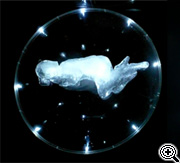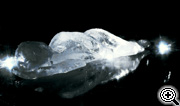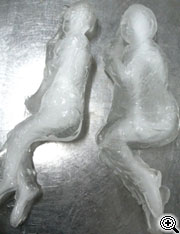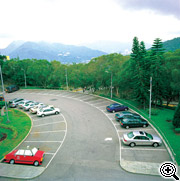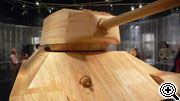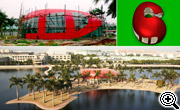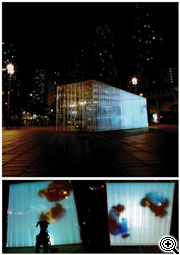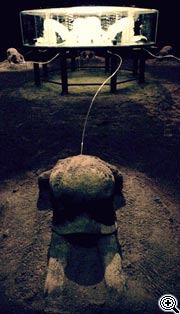Playing Devil's Advocate
Playing devil's advocate is not an easy task at a time when the accelerating disintegration of the social, intertwined with unparalleled technological advances and the endless availability of consumable pleasures, makes attempts to arrive at a hypothesis of utopic viability or to even imagine alternative societies seem either incredibly futile and impractical, or, at the other extreme, waywardly self-indulgent. The recent work of Amy Wan Man Cheung, however, appears to move peripatetically between these arguments while at the same time wrestle with their implications for the political. Her large-scale sculptures and public art projects entail restless and anxious oscillations between fantasy worlds and haunting reflections of life's realities, whimsical childhood fairytales and serious sci-fi commentaries, the total enchantment of surface effects and the ironic scrutiny of both. Cheung also plays extensively with heavy contrasts in her exploration of the material possibilities of installation: soft and hard, hot and cold, fragile and durable, transparent and opaque, the familiar and the unexpected. Neither exalted nor condemned, these oppositions - their unresolved tensions, the ways in which they constitute, contest and connect with each other - when taken as a dialectical system, help dislodge the artist's production from its otherwise paralyzing conditions and intensify experiences of the different worlds she creates - "construction sites," as she calls them, of the cultural imaginary and the real of socio-economic relations.
Recurring vehicular dream objects dominate Cheung's recent work in the large. Sculptural interventions - such as Down the Rabbit Hole, 'TAXI!' says Alice (2004), a lopsided red cab showing up in various geographies of nowhere (of the type of James Howard Kunstler) in Hong Kong and Guangzhou from taxi queue to parking lot to pier front - cross over to reality for a split second when encountered in unanticipated civic places. At the Hong Kong Heritage Museum, A Bleeding Toy From Childhood (2006), a huge life-size military tank realistically-rendered and made of wood typically used for children's model kits, is surrounded by thick walls of plastic blister packaging that are part of the overall exhibition design, but onto which Cheung emblazoned motifs of guns, bombs and other weapons of mass destruction. Equipped with an interactive video game console inside, the tank points to speculations on the transformation of an instrument of war into a deluxe sit-down arcade cabinet that can dole out entertainment violence on a simulacral level as effectively as network television. In Spacesofa Voyager 3000 (2002), the bases of two gigantic red armchairs have been tunneled through and refashioned into the ultimate playroom: a kids-only sophisticated space command centre, complete with a monitor-outfitted control room and flanking dressing and shower rooms filled with objects in all shapes and sizes to fine-tune those developing motor skills when distracted from the screen. For a generation overexposed to technology-oriented media and gaming culture, this space-efficient living room pod however merely pretends a channeling of children's play insofar as it remains wary of the impossibility of unmediated escape.
The relatively short distance between dreams of a better tomorrow and its potentially disastrous collision with transportation nightmares is exposed in Untitled (The Population) (2002), a public art project first created in the port city of Kaohsiung, Taiwan. A shipping container constructed entirely out of Plexiglas provides the videotecture onto which images are projected of an unidentifiable ghostly population of tightly-tucked bodies rolling across the sky bracing for their inevitable gravitational fall. Opulent when seen by night, with cargo transparency as its leitmotif (the visceral contents of this cinematic box are entirely visible), the glowing structure's affect is in stark contrast to the tragedy of concealment and entrapment behind the 58 dead Chinese bodies found asphyxiated aboard a container truck in Dover, England, in July 2000, for which this piece is a temporary memorial. In this dysfunctional Cinderella tale of illegal human trafficking (a strange small stone goat is shackled to the premises, next to a pair of stone baby shoes), the collective learned fantasy of a utopia on the other side of the globe, despite enormous calculated risks and the perils of a hazardous journey, cannot be disassociated from one of the most spectacularized fantasies of economic domination in recent history: Disney's utopian lands of milk and honey.
In her latest work, Devil's Advocate: A Song And A Landscape (2007), Cheung turns to the urban trope of Fantasy City (to use John Hannigan's term) with an alternative vision of Michael Sorkin's formulation of "the city as theme park." In this installation, a critique of the present-day fascination with urban spectacle, memory and star culture is initiated through the deployment of familiar theme park structures.
Intense debates on the destruction versus preservation of heritage buildings seem to order the transformation of urban landscapes in world cities like Hong Kong. Lamentable losses of monuments to Hong Kong's cultural identity in 2006 for the artist include the closing of the city's oldest prison built in 1841 when it was ceded to Britain and the demolition of the fabled Star Ferry terminal to make way for a four-lane highway in the city centre. The latter's replacement by a new "imagineered" pier built farther out into the harbour on reclaimed land was not entirely unforeseeable given the opening of Hong Kong Disneyland, the city's latest entertainment draw, on Lantau Island the year before at costs to taxpayers recoverable beginning in a decade's time.
Inside her current work for the Biennale, what is essentially a large refrigerated meat locker, a tall steel structure, though modeled after the six-armed Power Surge thrill ride, disappointingly operates like a Ferris wheel, slowly rotating one round per minute like a beacon at the end of the long dark room. Sealed off from the world outside and, to an extent, its larger mega-exhibition context, the mood of this room, cool and sterile, is more evocative of the controlled environment of a science laboratory than the uninhibited carnevalesque atmosphere of a theme park (à la Mikhail Bakhtin). Instead of seats filled with love-struck teenagers hoping for the picture perfect perch (there is of course no spectacular landscape view to behold here), at the end of the wheel's arms are fragile transparent spheres encasing crudely-fashioned ice figurines of elderly people, which, while not sufficient in number or variance to suggest a city population, amply intimates the global ageing crisis. Previously, Cheung used frozen molded figures in Atom Ocean (2006), a morose vanitas installation of four humanoid creatures supplicating in a raised round tank and destined to eventually melt through connected tubes into their sand-sculpted counterparts below. In Devil's Advocate, observations on human fallibility and the transience of life seem to have crystallized into prescriptions of techno-therapies for the body of the future. All unique and in different sleeping positions, the frail frozen figures - "citizens of a reality that might mirror our own but has its own logic," according to Cheung - seem to float mid-air in cryogenic pods that help constitute their own little Experimental Prototype Community Of Tomorrow (pace Disney).
Suspended in time, these senior denizens dwell without noise, bodily excess, risk of contamination or threat of social chaos; basically with none of the messiness of life. In this secluded environment, homelessness is a non-issue, heritage is a thing of the past, and the daily business of living and dying is just that. Circumstances, though, not unlike compact city living (except for the glass ceiling, and maybe the frigid temperatures) make it a pretty dull existence: despite not being more than three metres from each other, anonymity and isolation prevail here as well. On the flip side, the wheel of fortune's resemblance to a gigantic molecular model in star formation also brings forward related ecotopian commitments to the prehistory of the earth. In the early conceptual stages of the work, Cheung indicated that in questioning the possible meanings of Hong Kong's current star status, she was "most interested in how a star is formed in the forces of explosion, destruction and fire that illuminate the universe." "How much destruction," she wonders, "is needed in order to be reborn?"
As in earlier works, Devil's Advocate invites contemplation both at the level of representation and in its technical constitution. The urban fantasy is the starting point of the work's proposition: an understanding of the fantasy city not solely as a site for the fulfillment of desire, of fascination and attention, but as a construction site that by definition is always in process and wherein lies the possibility of a continuous reassessment and reconstruction of the relationship between human nature and technology. The installation does not necessarily suggest that the fantasy city is not as it should be: the beauty of the cryogenic garden as a paradigm of a utopian futurism is embraced. Rather, in the course of moving through the accentuated landscape approached ironically and ambiguously, the criticality of Cheung's work lies in its raising an acute awareness of the fragility and escape vulnerability of the very "conworlding" process itself (to put it in gaming terms). If the glassy baubles were to fall to the ground, they would shatter into shards; or, if the cooling technology fails, their human consignment would liquidate, turning back into its previous elemental state. Playing devil's advocate would paint the former as a picture of future society at its apocalyptic worst and the latter as probably no better in its deliverance of interim ecological worlds contained perpetually in souvenir Ocean Park snow globes. But with the idea of utopia in dire need of some serious effective therapy if it is to stay alive, to paraphrase Fredric Jameson; perhaps what is simply being pointed out by Cheung's Devil's Advocate is that the present world and its visions for the future are ultimately entirely of human design.
Alice Ming Wai Jim
AMY CHEUNG
Amy Cheung gained her BA in History of Art & Fine Art from Goldsmith's College, University of London in 1996 and her MFA in Mixed Media from the Slade School of Fine Art, the University of London in 1998. She has initiated numerous city interventions and public art projects both locally and abroad, for example, at the Studio Air - Helsinki 2000 European City of Culture Program and the Kaohsiung Museum of Fine Arts, International Container Arts Festival, Taiwan. Cheung was selected as one of Beck's New Contemporaries in U.K. 1997 and UNESCO-ASCHBERG Laureate in 2004.

